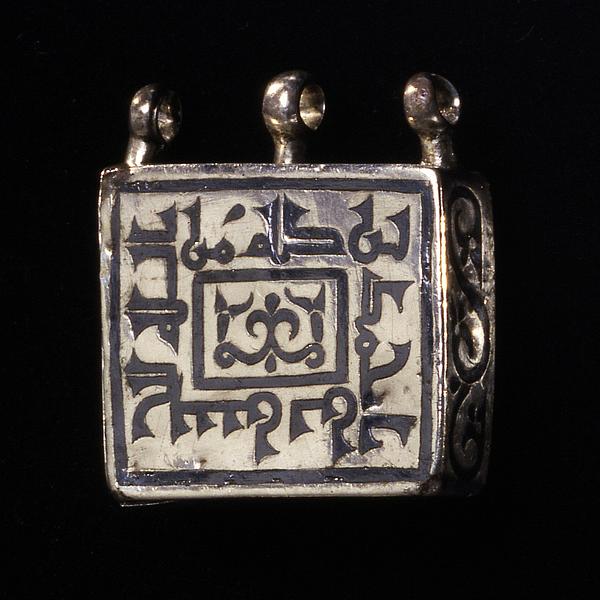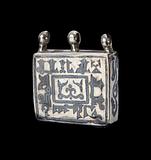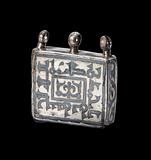Amulet case, silver inlaid with niello
Iran or Afghanistan; 10th-11th century
H incl. eyes: 4.6; W: 4.3; D: 1.2 cm
The contrast between the shiny polished silver and the deep-black niello is striking. Niello is an alloy of silver, lead, copper, or bismuth sulfides that is ground into a powder and then melted into depressions in the object.
The distinctive Kufi inscription – the Muslim profession of faith and a blessing on Hasan ibn Ahmad, who must have owned the amulet case – together with the vegetal elements are its only decoration. The almost square box has three eyes from which to hang it. One of them is on one short side, which is loose, so that an invocation or verse from the Koran can be put inside. The loose side must be a later replacement.
Inv. no. 8/1987
Published in:
Sotheby’s, London, 16/4-1987, lot 198;
Kjeld von Folsach: Islamic art. The David Collection, Copenhagen 1990, cat. 376;
Kjeld von Folsach, Torben Lundbæk and Peder Mortensen (eds.): Sultan, Shah and Great Mughal: the history and culture of the Islamic world, The National Museum, Copenhagen 1996, cat. 47;
Kjeld von Folsach: Art from the World of Islam in The David Collection, Copenhagen 2001, cat. 464;
Sarah Kiyanrad: Gesundheit und Glück für seinen Besitzer: schrifttragende Amulette im islamzeitlichen Iran (bis 1258), Würzburg 2017, Abb. 4, p. 365;
Joachim Meyer: “Ornament or symbol. Around an early group of silver amulet cases in the David Collection” in Journal of the David Collection, 2021, 5, fig. 3, pp. 10-11;
Nicolle, David: ”A Khanjar of Ibrâhîm Ibn Ilyâs Ibn Asad Ibn Sâmân dated 246 AH (28th March 860 to 17th March 861 AD)” in Arms and Armour, 19:1, 2022, pp. 8-9, fig. 4b;
Joachim Meyer, Rasmus Bech Olsen and Peter Wandel: Beyond words: calligraphy from the World of Islam, The David Collection, Copenhagen 2024, cat. 121, p. 294;





